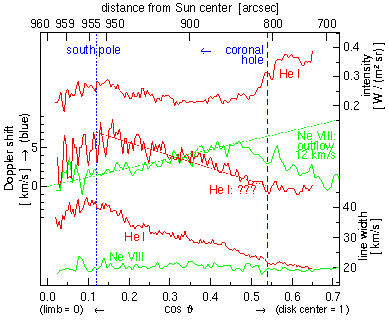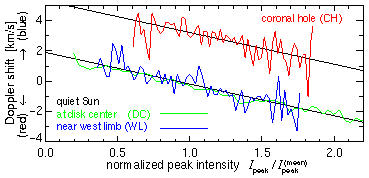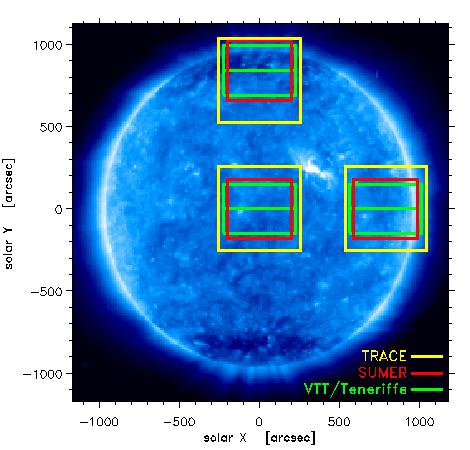Scientific rationale
Existing data: SUMER/SOHO He I (584 Å) full-disk scan
SUMER/SOHO observations of the full solar disk in He I (584 Å) clearly show the coronal holes in intensity, Doppler shift and line width (Peter 1999). In the coronal hole the intensity is reduced by a factor of 2, the line is blueshifted and much broader than in the quiet Sun. In the following those results of this observation are briefly summarized that are of interest for the proposed observations.[more information on the SUMER full-disk data and the raster images].
 from Peter (1999)
from Peter (1999)
 from Peter (1999)
from Peter (1999)
Existing data: He I (10830 Å) observations
Ground based observations in the He I (10830 Å) line that are of the same type as the SUMER 584 Å data described above were performed by Dupree et al. (1996).New observations: He I (584 Å) and He I (10830 Å)
As mentioned above the proposed observations in both the 584 Å (with SUMER/SOHO) and 10830 Å (with VTT/Teneriffe) will provide a much better observational basis than what is available up to now. To achieve this aim raster scans of regions of approx. 400 x 300 arcsec should be performed with increased sufficient signal-to-noise ratio and increased spectral resolution (see observations section).He II (304 Å)
The observations in the He I (584, 10830 Å) lines should be supported by observations in He II (304 Å). This will enable a further study of the line formation and a comparison of the spatial structures. As the expected Doppler shifts in the quiet Sun are quite small, it is still has to be decided if a observation with EIT in its 304 Å channel is sufficient of if also a CDS raster is of great use.Coronal and transition region radiation
To be able to study the line formation of the helium lines the coronal back radiation has to be known. Thus supporting observations of TRACE in a coronal channel, e.g. in 171 Å (Fe IX/FeX, 1 million K), is of great interest. Similarly observations in the C IV channel of TRACE is of interest to get information on the transition region emissionRelation to chromospheric emission
The spectrographs SUMER and VTT/Teneriffe will provide also information on chromospheric lines. This will enable to study the relation of Helium to other lines from the chromosphere and may give some hints where these lines are formed. In a way this would enable a spatial comparison similar to that performed for time series in He I (10830) and Ca K by Fleck et al. (1996).Underlying photospheric magnetic field
Information on the photospheric magnetic field (provided by MDI/SOHO) will allow to study the connection of the magnetic structure and spectral features in the helium lines.Planned Observations
Participating instruments
This is a MEUDOC campeign, i.e. the SOHO instruments will be coordinated from Paris.Planers/contact persons for the time of the planned helium observations:
| SUMER/SOHO: | Philippe Lemaire | lemaire@medoc-ias.u-psud.fr | 17. Mai - 23. Mai |
| Jean-Claude Vial | vial@ias.fr | 24. Mai - 30. Mai | |
| VTT/Teneriffe: | Wolfgang Schmidt | wolfgang@kis.uni-freiburg.de | 19. Mai - 26. Mai |
| TRACE: | Harry Warren | hwarren@cfa.harvard.edu | 18. Mai - 24. Mai |
| CDS/SOHO: | Andrzej Fludra | fludra@cds8.nascom.nasa.gov | |
| EIT/SOHO: | Frederic Auchere | auchere@filament.nascom.nasa.gov | 2. Mai - 29. Mai |
| MDI/SOHO: | Craig DeForest | zowie@urania.nascom.nasa.gov |
Schedule for observations
- from Mai 21 to 26, 1999
- each day from 9:00 to 12:30 UT
(best time for ground based observation at VTT) - after one good run in each of the three regions (see below) is obtained: stop the program
Observational sequences and status
| SUMER/SOHO: |
|
| VTT/Teneriffe: Observatorio del Teide |
|
| TRACE: |
|
| CDS/SOHO: |
|
| EIT/SOHO: |
|
| MDI/SOHO: |
|
Regions/field-of-view covered by participating instruments
Study three regions in coronal hole, quiet Sun at disk center and quiet Sun near the limb(Of course they may change from north/south hole or east/west limb.)
This assumes that SOHO is back to its "original" orientation, i.e. that the SUMER-slit is in the N-S direction and that north is top in the EIT and MDI images.

References
-
Andretta V. & Jones H.P. (1997), ApJ 489, 375-394
On the Role of the Solar Corona and Transition Region in the Excitation of the Spectrum of Neutral Helium
Carlsson M. & Stein, R.F. (1997), ApJ 481, 500-514
Formation of Solar Calcium H and K Bright Grains
Dupree A.K., Penn M.J. & Jones H.P. (1996), ApJ 467, L121-L124
He I 10830 Å Wing Asymmetry in Polar Coronal Holes:
Evidence for Radial Outflows
Fleck et al. (1996)
Hammer R. (1997), in Proc. 5th SOHO Workshop, ESA SP-404, p. 141-147
The Quiet Corona and Regular Solar Wind
Peter H. (1999), ApJ, to be submitted
Origin of the Helium lines in the Solar Atmosphere:
The SUMER/SOHO He I (584 Å) Full-Disk Scan
Hardi PETER | High Altitude Observatory / NCAR
| Phone: (303) 497-8324
|
| P.O. Box 3000
| Fax: (303) 497-1589
|
| Boulder, CO 80307-3000
| E-mail:
hpeter@ucar.edu
|
| U.S.A
|
http://www.asp.ucar.edu/~hpeter/
| |